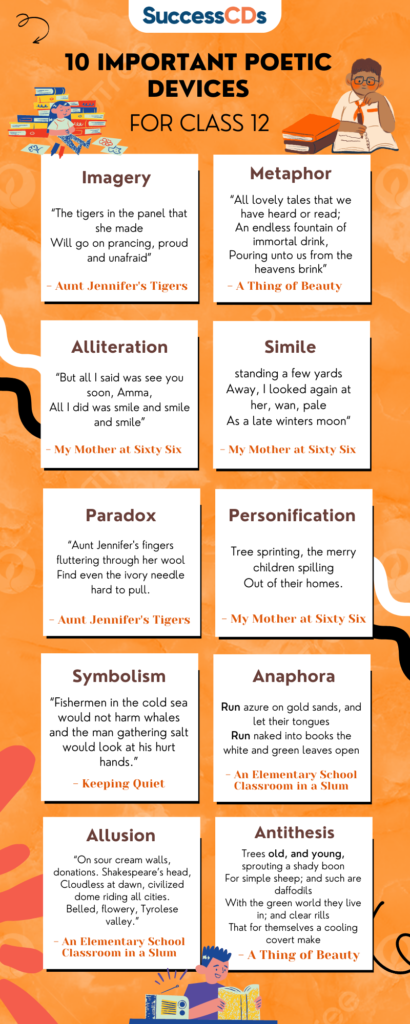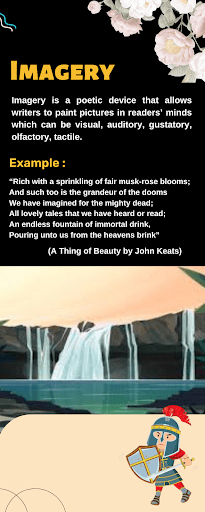List of Important Poetic Devices for Class 12 English Poems
In order to get good grades in the poetry questions, a student must have a clear understanding of the different figures of speech used in the class 12 poems. In this article we have listed and described the important poetic devices with examples so that the learners can get a clear understanding.
To start with, let us see what poetic devices are
What are Poetic Devices?
Poetic devices are a form of literary devices which are used in poetry. In literature, a poetic device is a technique that creates a specific effect in a poem.
Poetry offers plenty of opportunities for exploration and experimentation of many notions, ideas, and concepts. Therefore, poetic devices are instruments that greatly improve a poem’s content, heighten a mood, or provide a necessary rhythm. Understanding the different kinds of poetic devices employed can be a valuable way to develop your appreciation for the poetic art form.
Wish to know more? Keep scrolling to know about the most important poetic devices used in class 12 Flamingo book poems

- Imagery
Imagery is a poetic device that allows writers to paint pictures in readers’ minds which can be visual, auditory, gustatory, olfactory, tactile.
Example-
“Rich with a sprinkling of fair musk-rose blooms;
And such too is the grandeur of the dooms
We have imagined for the mighty dead;
All lovely tales that we have heard or read;
An endless fountain of immortal drink,
Pouring unto us from the heavens brink”
(A Thing of Beauty by John Keats)

“The tigers in the panel that she made
Will go on prancing, proud and unafraid”
(Aunt Jennifer’s Tigers by Adrienne Rich)
- Metaphor
Metaphor is an indirect comparison between two dissimilar objects. The poet draws a similarity between any quality of these objects.
Example-
The paper seeming Boy, with rat’s eyes.
( An Elementary School Classroom in a Slum by Stephen Spender)
The boy is very thin just like a sheet of paper.
“ All lovely tales that we have heard or read;
An endless fountain of immortal drink,
Pouring unto us from the heavens brink”
(A Thing of Beauty by John Keats)
The poet has compared the components of nature with immortal drinks.
- Alliteration
Alliteration is a poetic device in which consonant sounds are repeated at the beginning of words.
Example-
“ But all I said was see you soon, Amma,
All I did was smile and smile and smile” – repetition of letter ‘s’
(My Mother at Sixty Six by Kamala Das)
“ That for themselves a cooling covert make”
(A Thing of Beauty by John Keats)
- Enjambment
An enjambment is the continuation of a sentence beyond a line break, couplet, or stanza without an expected pause.
Example-
“And for once could perhaps a huge silence
might interrupt this sadness
of never understanding ourselves
and of threatening ourselves with death.”
(Keeping Quiet by Pablo Neruda)
“ A thing of beauty is a joy forever
Its loveliness increases, it will never
Pass into nothingness; but will keep
A bower quiet for us, and a sleep
Full of sweet dreams, and health, and quiet breathing.”
( A Thing of Beauty by John Keats)
- Simile
The simile offers a device for comparison. The subject of the poem is described by comparing it to another object or subject, using ‘as’ or ‘like’.
Example-
“ But after the airports
Security check, standing a few yards
Away, I looked again at her, wan, pale
As a late winters moon “
( My Mother at sixty six by Kamala Das)
The poetess’ mother’s face has been compared to the late winters moon using as.
“ Far far from gusty waves these children’s faces.
Like rootless weeds, the hair was torn round their pallor”
( An Elementary School Classroom in a Slum by Stephen Spender)
The faces of the children have been compared to rootless weeds using “like”.
- Paradox
A paradox is a poetic device that is made up of two opposite things and seems impossible or untrue but is actually possible or true.
Example-
“Aunt Jennifer’s fingers fluttering through her wool
Find even the ivory needle hard to pull.
The massive weight of Uncles wedding band
Sits heavily upon Aunt Jennifer’s hand.”
(Aunt Jennifer’s Tigers by Adrienne Rich)
Here, someone whose fingers are fluttering is creating something that requires certainty.
- Personification
Personification is a poetic device in which animals, plants, or even inanimate objects are endowed with human characteristics.
Example-
“ And realised with pain
That she was old as she looked but soon
Put that thought away and looked out at young
Tree sprinting, the merry children spilling
Out of their homes.”
(My Mother at Sixty Six by Kamala Das)
The trees are said to be running (sprinting).
- Symbolism
Poets use symbolism to convey hidden meanings. Symbolism is the use of symbols to signify ideas and qualities, by giving them symbolic meanings that are different from their literal sense.
Example –
“ Fishermen in the cold sea
would not harm whales
and the man gathering salt
would look at his hurt hands.”
(Keeping Quiet by Pablo Neruda)
The poet has used fisherman as a symbol of the oppressor and whale as a symbol of the oppressed.
- Anaphora
Anaphora is the repetition of words or phrases in two or more consecutive poetic lines.
Example-
“ And show the children to green fields, and make their world
Run azure on gold sands, and let their tongues
Run naked into books the white and green leaves open
History theirs whose language is the sun.”
( An Elementary School Classroom in a Slum by Stephen Spender)
“ For once on the face of the Earth
lets not speak in any language,
lets stop for one second,
and not move our arms so much”
(Keeping Quiet by Pablo Neruda)
“ Spite of despondence, of the inhuman dearth
Of noble natures, of the gloomy days,
Of all the unhealthy and oer-darkened ways”
( A Thing of Beauty by John Keats)
- Allusion
An allusion is a reference to a person, place, thing or event.
Example-
“ On sour cream walls, donations. Shakespeare’s head,
Cloudless at dawn, civilized dome riding all cities.
Belled, flowery, Tyrolese valley.”
( An Elementary School Classroom in a Slum by Stephen Spender)
The poet makes a reference to the Tyrolese Valley which is situated in Austria.
- Antithesis
The use of words that are opposites in meaning. These should be closely placed.
Example-
Trees old, and young, sprouting a shady boon
For simple sheep; and such are daffodils
With the green world they live in; and clear rills
That for themselves a cooling covert make
‘Gainst the hot season; the mid forest brake
(A Thing of Beauty by John Keats)
- Assonance
Assonance, or “vowel rhyme,” is the repetition of vowel sounds across neighbouring words in poetry.
Example-
“ Drive from my parents
Home to cochin last friday
morning. I saw my mother, beside me,
doze, open mouthed, her face ashen like that of a corpse”
(My Mother at Sixty Six by Kamala Das)
Prominent sound of ‘o’:
“victory with no survivors
would put on clean clothes
and walk about with their brothers”
(Keeping Quiet by Pablo Neruda)
Prominent sound of the vowel ‘o’
“They do not fear the men beneath the tree.”
( Aunt Jennifer’s Tigers by Adrienne Rich)
Prominent sound of the vowel ‘e’
- Consonance
The term ‘consonance’ refers to the use of words with similar consonant sounds in neighbouring words in a poem
Example-
“ Put that thought away and looked out at young”
(My Mother at Sixty Six by Kamala Das)
Prominent sound of ‘t’
Jennifer’s tigers prance across a screen.
( Aunt Jennifer’s Tigers by Adrienne Rich)
Prominent sound of consonant ‘s’
“The tigers in the panel that she made
Will go on prancing, proud and unafraid”
(Aunt Jennifer’s Tigers by Adrienne Rich)
Also See :
- Poetic Devices, Literary Devices in Poems, Examples, explanation
- Top Poetic Devices for Class 9 | Poetic Devices with Examples
- 10 Important Poetic Devices for Class 10 with Examples
- Poetic Devices in Class 10 English Communicative Poems
- 10 Poetic Devices with Examples for Class 11 Poems
- CBSE Class 12 English Notes, Lesson Explanation, Question Answers
- CBSE Class 12 English MCQ Question Answers
- Class 12 English Flamingo Book Chapter wise word meaning
- Class 12 English Flamingo Poems Word meaning
- Class 12 English Vistas Book Word meanings
- CBSE Class 12 English Important Question Answers
- Character Sketch of Class 12 English